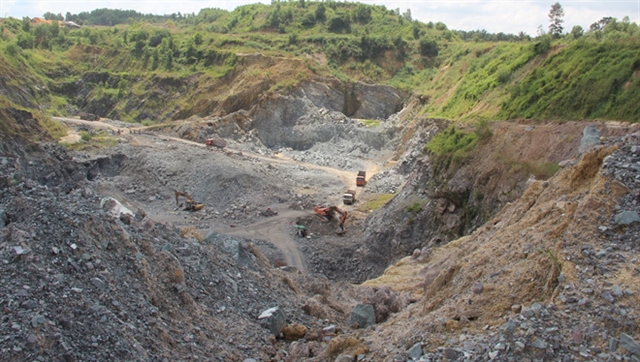 Society
Society


|
| Limestone quarries create the deep holes of 60-80m along the Buông River in southern Đồng Nai Province, which may affect the river flow and its water supply in the future. — Photo thanhnien.com.vn |
ĐỒNG NAI Provincial authorities in the southern province of Đồng Nai have asked the Ministry of Natural Resources and Environment to make compiling environmental impact assessments mandatory for quarry complexes in the province before they can operate.
Nguyễn Ngọc Hưng, deputy director of the provincial Department of Natural Resources and Environment, said the province had tens of limestone quarries, mostly in Biên Hoà City and Vĩnh Cửu and Thống Nhất districts and forming three large complexes.
Hưng said all the quarries have undergone separate environmental impact assessments and been approved by the ministry. However, the ministry has not evaluated the three complexes individually due to a lack of regulations.
This has harmed the environment during and after the limestone mining process, he said.
Hưng said there were 10 quarries in Phước Tân quarry complex in Biên Hoà City, along the two sides of the Buông River. All of the quarries are legal and were evaluated the environmental impact assessment.
These quarries were licensed to operate between four and 25 years on 403ha. The total amount of exploited limestone was estimated to be 130 million cu.m to a depth of up to 80m.
Hưng said five out of 10 quarries were only 50m from the river and each quarry was hundreds of metres long. The quarries have left deep holes along the river after the mining process, seriously impacting river flow.
The river could even run dry due to these holes, he said.
The 52km Buông River is the largest river in Đồng Nai. It supplies water for 233,000 residents, hundreds of hectares of rice and 14,000ha of trees.
The calculation of air pollution caused by the quarry complexes was another issue. The latest air monitoring report from the department showed the amount of dust at Phước Tân quarry complex in Biên Hoà City and Thiện Tân quarry complex in Vĩnh Cửu District was between 1.12 and 16.24 times higher than allowed levels.
Hưng said the environmental impact assessment was necessary for the quarry complexes, but none of the localities had carried one out.
The department plans to hire a consultancy unit to evaluate the overall impact of the quarry complexes on the surrounding environment.
The department has proposed the Ministry of Natural Resources and Environment provide guidelines for the evaluation of the environmental impact assessment in quarry complexes in the province.
Đồng Nai Province has the largest limestone reserve in the south region, with 32 quarries and mining capacity of more than 22 million cu.m per year. VNS




